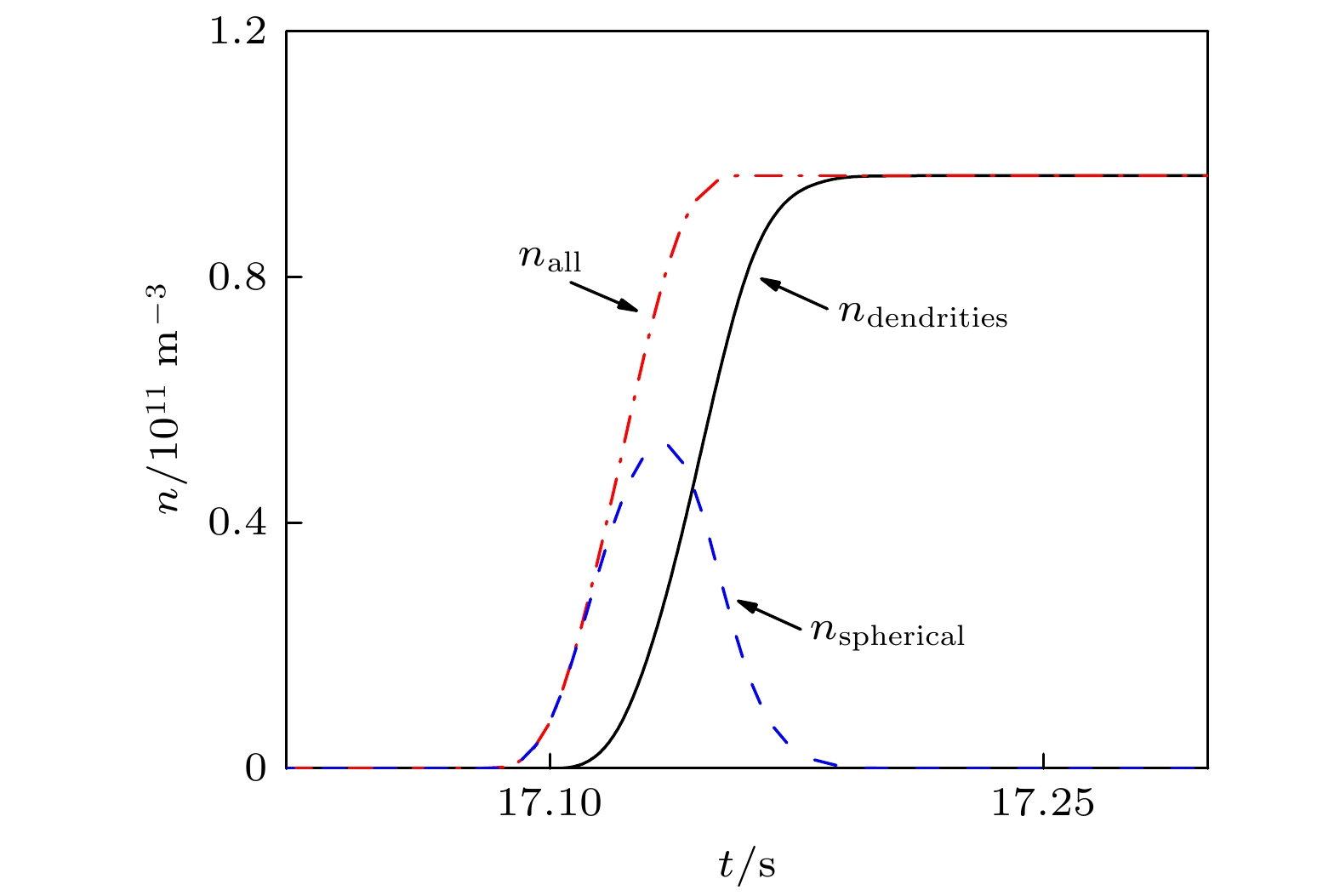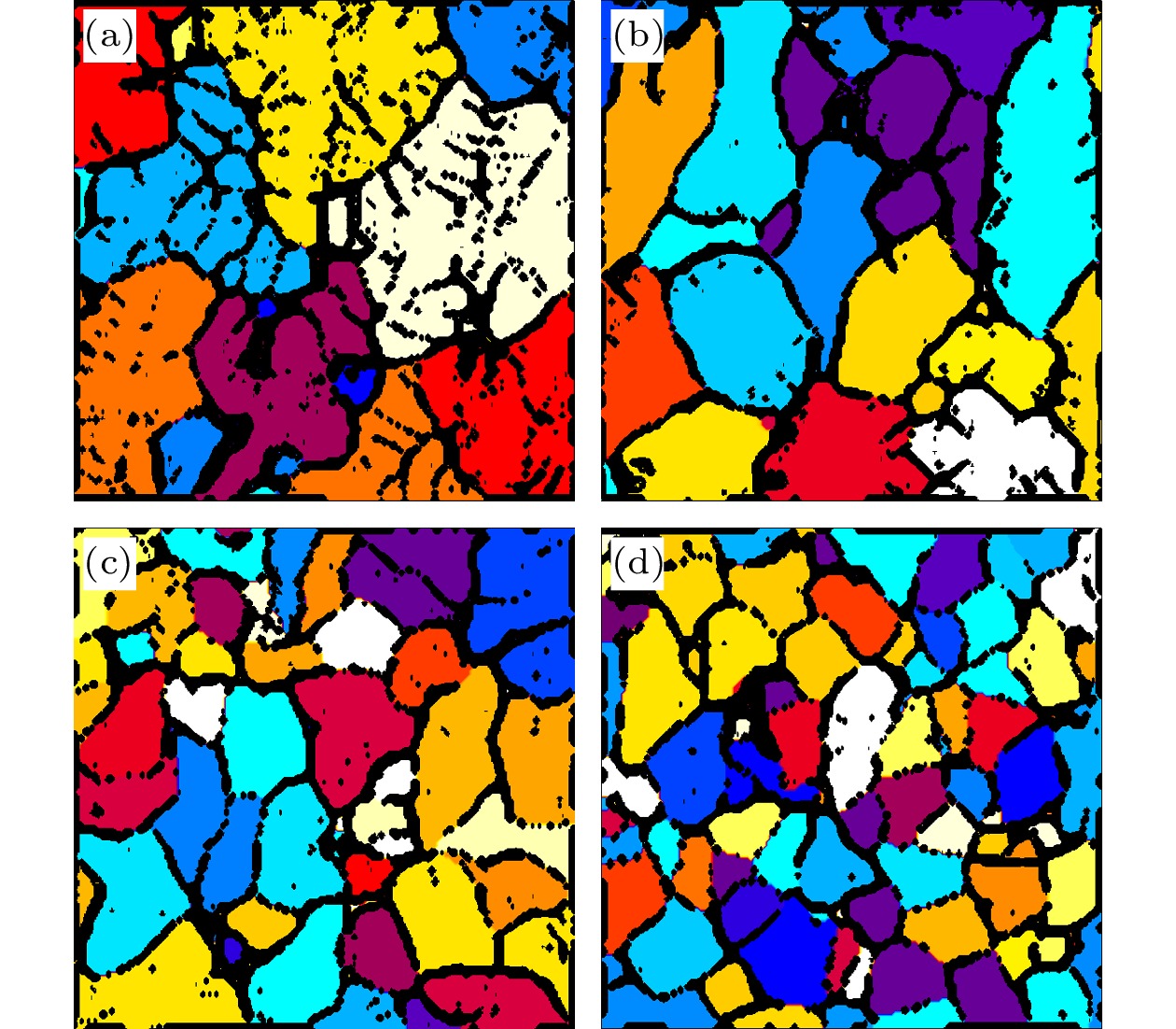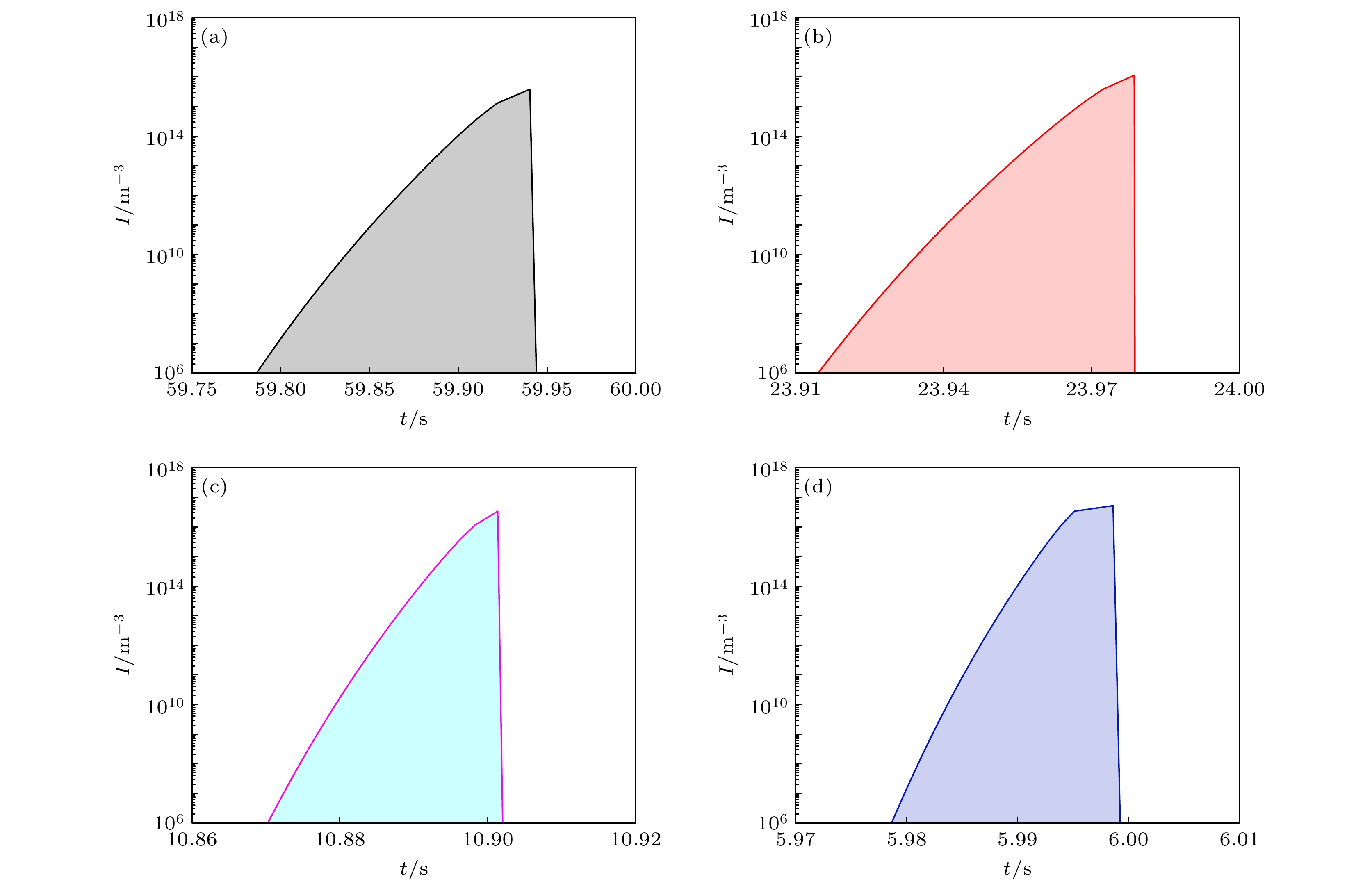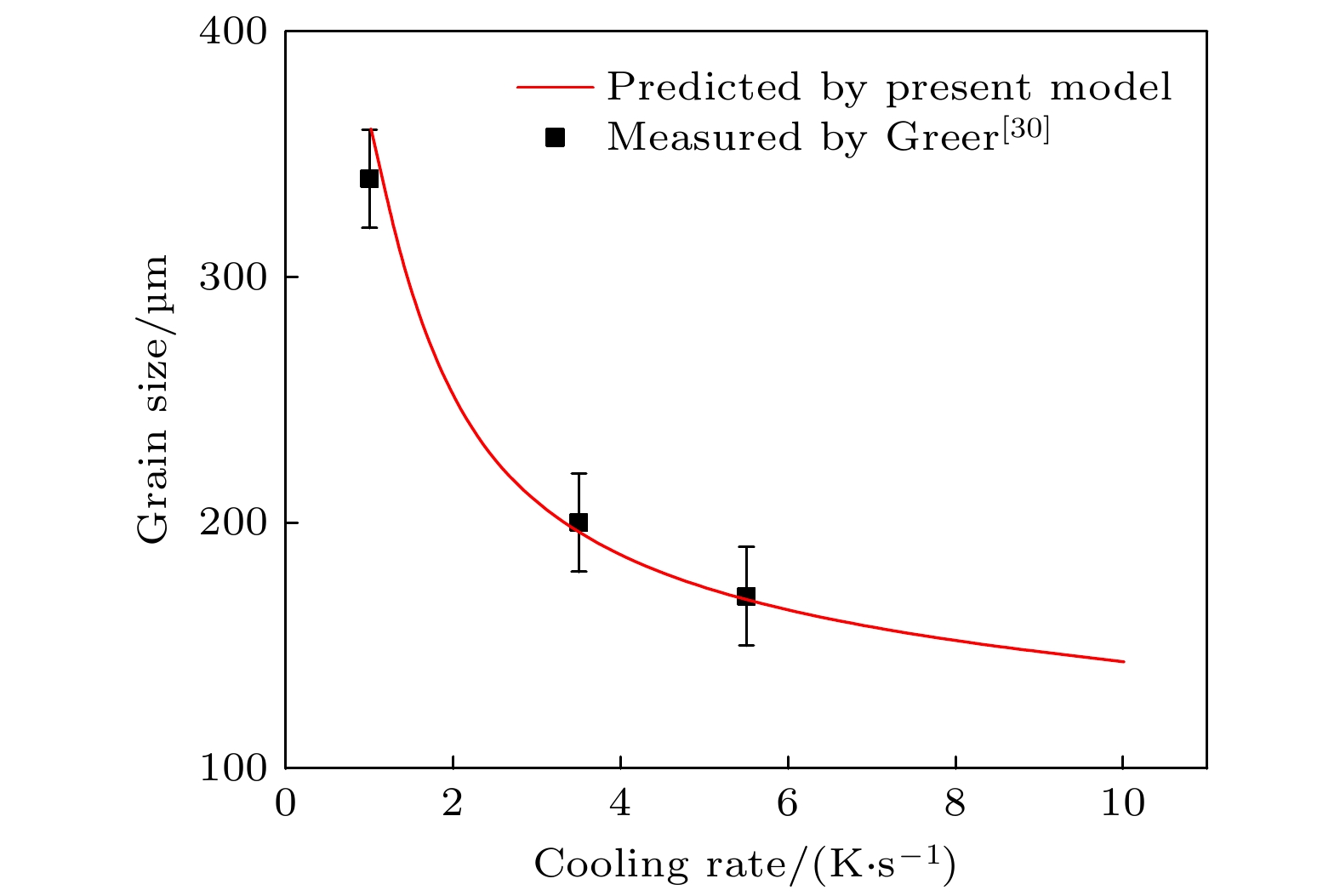-
采用耦合群体动力学方法与元胞自动机方法建立了细化处理条件下铝合金凝固微观组织演变的数值模型. 该模型考虑了α-Al的非均匀形核过程、晶粒的初始球形长大以及之后的枝晶生长过程. 利用建立的模型模拟了Al-5Ti-1B中间合金细化工业纯铝凝固组织演变过程. 结果表明: 形核初始阶段, 熔体中存在充足数量的有效形核粒子, α-Al形核率随着熔体过冷度的增大逐渐增高; 形核开始不久后, α-Al的异质形核过程由熔体中有效形核粒子数量控制, 直到再辉发生, 形核停止. 模拟分析了中间合金添加量以及熔体冷却速度对工业纯铝凝固组织演变过程的影响, 模拟结果与实验结果相符, 验证了模型的准确性.Solidification microstructure of aluminum alloy has a great influence on the properties of the casting. An aluminum alloy with the structure of fine equiaxed grains has low casting defects and presents excellent mechanical properties. Recently, chemical inoculation by adding grain refiner is the technique most extensively used to achieve a fine, equiaxed grain structure of Al alloy in the industrial production. In order to investigate the detailed solidification microstructure evolution of the alloy, many numerical models have been proposed. Cellular automaton method is one of the powerful tools for simulating the morphology evolution of detailed grains in the solidification process of alloy. However, the present cellular automata model has a shortcoming, that is, its calculation of the nucleation rate is based on the experimental number density of grains. In this work, a population dynamics-cellular automaton model is developed for describing the solidification microstructure evolution of the inoculated aluminum alloy. The model takes account of the heterogeneous nucleation of α-Al nucleus, the initial spherical growth of α-Al grains and the dendritic growth process. The model is used for simulating the solidification microstructure evolution of the commercial-purity aluminum (CP-Al) inoculated by Al-5Ti-1B master alloy. The results indicate that the heterogeneous nucleation process of α-Al can be divided into the two stages. In the early stage of nucleation, there are enough effective particles in the melt. The nucleation rate of α-Al increases with the increase of the undercooling of the melt. After a short time, the nucleation of α-Al is dominated by the number density of the effective particles in the melt. Nucleation process stops when the recalescence takes place. The effects of the additive amount of Al-5Ti-1B master alloy and the cooling rate of the melt on the solidification microstructure of the CP-Al are investigated by using the established model. The final solidification structures of CP-Al are predicted. And a comparison between the predicted results and the experimental ones shows that they are in good agreement with each other.
-
Keywords:
- aluminum alloys /
- nucleation /
- grains growth /
- modeling
[1] Murty B S, Kori S A, Chakraborty M 2002 Int. Mater. Rev. 47 3
 Google Scholar
Google Scholar
[2] Guo G R, Tie D 2017 Acta Metall. Sinica 30 409
 Google Scholar
Google Scholar
[3] Liu Z 2017 Metall. Mater. Trans. 48 4755
 Google Scholar
Google Scholar
[4] Greer A L 2016 J. Chem. Phys. 145 211704
 Google Scholar
Google Scholar
[5] Zhang L L, Jiang H X, Zhao J Z, He J 2017 J. Mater. Process. Technol. 246 205
 Google Scholar
Google Scholar
[6] Jiang H X, Sun Q, Zhang L L, Zhao J Z 2018 J. Alloys Compd. 748 774
 Google Scholar
Google Scholar
[7] StJohn D H, Qian M, Easton M A, Cao P 2011 Acta Mater. 59 4907
 Google Scholar
Google Scholar
[8] Quested T E, Greer A L 2004 Acta Mater. 52 5233
 Google Scholar
Google Scholar
[9] Easton M, StJohn D 2005 Metall. Mater. Trans A. 36A 1911
 Google Scholar
Google Scholar
[10] Qian M, Cao P, Easton M A, McDonald S D, StJohn D H 2010 Acta Mater. 58 3262
 Google Scholar
Google Scholar
[11] Wheeler A A, Boettinger W J, McFadden G B 1992 Phys. Rev. A 45 7424
 Google Scholar
Google Scholar
[12] Boussinot G, Apel M 2017 Acta Mater. 122 310
 Google Scholar
Google Scholar
[13] 陈云, 康秀红, 李殿中 2009 58 390
 Google Scholar
Google Scholar
Chen Y, Kang X H, Li D Z 2009 Acta Phys. Sin. 58 390
 Google Scholar
Google Scholar
[14] 单博炜, 林鑫, 魏雷, 黄卫东 2009 58 1132
 Google Scholar
Google Scholar
Shan B W, Lin X, Wei L, Huang W D 2009 Acta Phys. Sin. 58 1132
 Google Scholar
Google Scholar
[15] 赵九洲, 李璐, 张显飞 2014 金属学报 50 641
 Google Scholar
Google Scholar
Zhao J Z, Li L, Zhang X F 2014 Acta Metall. Sin. 50 641
 Google Scholar
Google Scholar
[16] Gandin C A, Rappaz M 1994 Acta Metall. Mater. 42 2233
 Google Scholar
Google Scholar
[17] Zhu M F, Hong C P 2001 ISIJ Int. 41 436
 Google Scholar
Google Scholar
[18] 石玉峰, 许庆彦, 柳百成 2013 61 108101
 Google Scholar
Google Scholar
Shi Y F, Xu Q Y, Liu B C 2013 Acta Phys. Sin. 61 108101
 Google Scholar
Google Scholar
[19] 潘诗琰, 朱鸣芳 2009 58 278
 Google Scholar
Google Scholar
Pan S Y, Zhu M F 2009 Acta Phys. Sin. 58 278
 Google Scholar
Google Scholar
[20] Zhang X F, Zhao J Z, Jiang H X, Zhu M F 2012 Acta Mater. 60 2249
 Google Scholar
Google Scholar
[21] Mullins W W, Sekerka R F 1963 J. Appl. Phys. 34 323
 Google Scholar
Google Scholar
[22] 张丽丽, 江鸿翔, 赵九洲, 李璐, 孙倩 2017 金属学报 53 1091
 Google Scholar
Google Scholar
Zhang L L, Jiang H X, Zhao J Z, Li L, Sun Q 2017 Acta Metall. Sin. 53 1091
 Google Scholar
Google Scholar
[23] 邓聪坤, 江鸿翔, 赵九洲, 何杰, 赵雷 2020 金属学报 56 212
 Google Scholar
Google Scholar
Deng C K, Jiang H X, Zhao J Z, He J, Zhao L 2020 Acta Metall. Sin. 56 212
 Google Scholar
Google Scholar
[24] 张显飞 2012 博士学位论文 (沈阳: 中国科学院金属研究所)
Zhang X F 2012 Ph. D. Dissertation (Shenyang: Institute of Metal Research, Chinese Academy of Sciences) (in Chinese)
[25] 江鸿翔, 赵九洲 2011 金属学报 47 1099
 Google Scholar
Google Scholar
Jiang H X, Zhao J Z 2011 Acta Metall. Sin. 47 1099
 Google Scholar
Google Scholar
[26] 陈海林 2008 博士学位论文 (长沙: 中南大学)
Chen H L 2008 Ph. D. Dissertation (Changsha: Central South University) (in Chinese)
[27] Ansara I, Dinsdale A T, Rand M H 1998 Cost 507: Thermochemical Database for Light Metal Alloys (Vol. 2) (Luxembourg: Office for Official Publications of the European Communities)
[28] Xu Y J, Zhao D D, Li Y J 2018 Metall. Mater. Trans. A 49 1770
 Google Scholar
Google Scholar
[29] 傅献彩, 沈文霞, 姚天杨, 侯文华 2007 物理化学(上册) (北京: 高等教育出版社) 第168页
Fu X C, Shen W X, Yao T Y, Hou W H 2007 Physical Chemistry (Vol. 1) (Beijing: Higher Education Press) p168 (in Chinese)
[30] Greer A L, Bunn A M, Tronche A 2000 Acta Mater. 48 2823
 Google Scholar
Google Scholar
[31] Quested T E, Greer A L 2005 Acta Mater. 53 4643
 Google Scholar
Google Scholar
[32] Men H, Fan Z 2011 Acta Mater. 59 2704
 Google Scholar
Google Scholar
-
图 1 0.01% Al-5Ti-1B中间合金细化处理工业纯铝凝固过程中, 熔体过饱和度S = Cl – Ce, α-Al形核驱动力ΔGV, 异质形核率I随时间的变化. 熔体冷速为3.5 K/s
Fig. 1. The supersaturation of the melt S = Cl – Ce (dash line), the driving force of nucleation ΔGV (dot line) and the heterogeneous nucleation rate I (solid line) of α-Al during cooling the CP-Al melt inoculated by 0.01% Al-5Ti-1B master alloy at the cooling rate of 3.5 K/s.
图 3 0.01% Al-5Ti-1B中间合金细化处理工业纯铝凝固过程中, α-Al晶核总数量nall, 球状晶nspherical以及树枝晶数目ndendrities随时间的变化. 熔体冷速为3.5 K/s
Fig. 3. The number density of all nucleus nall in the Al melt, the number density of spherical nucleus nspherical and the number density of dendrities ndendrities during cooling the CP-Al melt inoculated by 0.01% Al-5Ti-1B master alloy at the cooling rate of 3.5 K/s.
图 4 0.01% Al-5Ti-1B中间合金细化处理工业纯铝凝固微观组织演变过程 (a) 固相分数 = 0.1%; (b) 固相分数 = 1.0%; (c) 固相分数 = 25.0%; (d) 固相分数 = 70.0%. 熔体冷速为3.5 K/s. 计算区域尺寸为600 μm × 600 μm × 600 μm
Fig. 4. Solidification microstructure evolution during cooling the CP-Al melt inoculated by 0.01% Al-5Ti-1B master alloy at a cooling rate of 3.5 K/s: (a) Solid fraction = 0.1%; (b) solid fraction = 1.0%; (c) solid fraction = 25.0%; (d) solid fraction = 70.0%. The size of computational domain is 600 μm × 600 μm × 600 μm.
图 6 不同数量Al-5Ti-1B中间合金细化工业纯铝凝固组织模拟结果 (a) 0.005%; (b) 0.01%; (c) 0.4%; (d) 1.0%. 熔体冷速为3.5 K/s. 计算区域尺寸为900 μm × 900 μm × 900 μm
Fig. 6. Simulated solidification microstructure for the CP-Al melt inoculated by different amount of Al-5Ti-1B master alloy at a cooling rate of 3.5 K/s: (a) 0.005%; (b) 0.01%; (c) 0.4%; (d) 1.0%. The size of computational domain is 900 μm × 900 μm × 900 μm.
图 8 不同冷却速度下经0.5% Al-5Ti-1B中间合金细化处理, 工业纯铝凝固时α-Al形核率随时间的变化 (a) 1.0 K/s; (b) 2.0 K/s; (c) 5.5 K/s; (d) 10.0 K/s
Fig. 8. Calculated heterogeneous nucleation rate of α-Al during cooling the CP-Al inoculated by 0.5% Al-5Ti-1B master alloy at the different rate: (a) 1.0 K/s; (b) 2.0 K/s; (c) 5.5 K/s; (d) 10.0 K/s.
图 9 0.5%Al-5Ti-1B中间合金细化工业纯铝, 在不同冷却速度凝固后凝固组织的模拟结果 (a) 1.0 K/s; (b) 2.0 K/s; (c) 5.5 K/s; (d) 10 K/s. 计算区域尺寸为900 μm × 900 μm × 900 μm
Fig. 9. Simulated solidification microstructure for the CP-Al melt inoculated by 0.5% Al-5Ti-1B master alloy at the different cooling rate of the melt: (a) 1.0 K/s; (b) 2.0 K/s; (c) 5.5 K/s; (d) 10 K/s. The size of computational domain is 900 μm × 900 μm × 900 μm.
Element Liquidus slope, m Partition coefficient, k Solute composition/% (weight percent) Q Fe –2.925 0.030 0.0825 0.234 Si –6.62 0.120 0.0475 0.276 Ga –2.52 0.140 0.0125 0.028 Ni –3.50 0.004 0.0051 0.018 V 9.71 3.330 0.0079 0.167 Ti 25.63 7.000 0.0042 0.63 Na –7.84 0.013 0.0015 0.012 Parameter Value Cooling rate of the CP-Al melt/(K·s–1) 3.5 Strength of the anisotropy of the
interfacial energy, ε0.04 Gibbs-Thomson coefficient, $\varGamma $/mK 1.42 × 107 Heat capacity of Al melt, CP/(J·K–1·m3) 2.58 × 106 Average jump distance of Al atoms
in Al melt, δ/m2.87 × 10–10 Boltzmann’s constant, kB 1.38 × 10–23 -
[1] Murty B S, Kori S A, Chakraborty M 2002 Int. Mater. Rev. 47 3
 Google Scholar
Google Scholar
[2] Guo G R, Tie D 2017 Acta Metall. Sinica 30 409
 Google Scholar
Google Scholar
[3] Liu Z 2017 Metall. Mater. Trans. 48 4755
 Google Scholar
Google Scholar
[4] Greer A L 2016 J. Chem. Phys. 145 211704
 Google Scholar
Google Scholar
[5] Zhang L L, Jiang H X, Zhao J Z, He J 2017 J. Mater. Process. Technol. 246 205
 Google Scholar
Google Scholar
[6] Jiang H X, Sun Q, Zhang L L, Zhao J Z 2018 J. Alloys Compd. 748 774
 Google Scholar
Google Scholar
[7] StJohn D H, Qian M, Easton M A, Cao P 2011 Acta Mater. 59 4907
 Google Scholar
Google Scholar
[8] Quested T E, Greer A L 2004 Acta Mater. 52 5233
 Google Scholar
Google Scholar
[9] Easton M, StJohn D 2005 Metall. Mater. Trans A. 36A 1911
 Google Scholar
Google Scholar
[10] Qian M, Cao P, Easton M A, McDonald S D, StJohn D H 2010 Acta Mater. 58 3262
 Google Scholar
Google Scholar
[11] Wheeler A A, Boettinger W J, McFadden G B 1992 Phys. Rev. A 45 7424
 Google Scholar
Google Scholar
[12] Boussinot G, Apel M 2017 Acta Mater. 122 310
 Google Scholar
Google Scholar
[13] 陈云, 康秀红, 李殿中 2009 58 390
 Google Scholar
Google Scholar
Chen Y, Kang X H, Li D Z 2009 Acta Phys. Sin. 58 390
 Google Scholar
Google Scholar
[14] 单博炜, 林鑫, 魏雷, 黄卫东 2009 58 1132
 Google Scholar
Google Scholar
Shan B W, Lin X, Wei L, Huang W D 2009 Acta Phys. Sin. 58 1132
 Google Scholar
Google Scholar
[15] 赵九洲, 李璐, 张显飞 2014 金属学报 50 641
 Google Scholar
Google Scholar
Zhao J Z, Li L, Zhang X F 2014 Acta Metall. Sin. 50 641
 Google Scholar
Google Scholar
[16] Gandin C A, Rappaz M 1994 Acta Metall. Mater. 42 2233
 Google Scholar
Google Scholar
[17] Zhu M F, Hong C P 2001 ISIJ Int. 41 436
 Google Scholar
Google Scholar
[18] 石玉峰, 许庆彦, 柳百成 2013 61 108101
 Google Scholar
Google Scholar
Shi Y F, Xu Q Y, Liu B C 2013 Acta Phys. Sin. 61 108101
 Google Scholar
Google Scholar
[19] 潘诗琰, 朱鸣芳 2009 58 278
 Google Scholar
Google Scholar
Pan S Y, Zhu M F 2009 Acta Phys. Sin. 58 278
 Google Scholar
Google Scholar
[20] Zhang X F, Zhao J Z, Jiang H X, Zhu M F 2012 Acta Mater. 60 2249
 Google Scholar
Google Scholar
[21] Mullins W W, Sekerka R F 1963 J. Appl. Phys. 34 323
 Google Scholar
Google Scholar
[22] 张丽丽, 江鸿翔, 赵九洲, 李璐, 孙倩 2017 金属学报 53 1091
 Google Scholar
Google Scholar
Zhang L L, Jiang H X, Zhao J Z, Li L, Sun Q 2017 Acta Metall. Sin. 53 1091
 Google Scholar
Google Scholar
[23] 邓聪坤, 江鸿翔, 赵九洲, 何杰, 赵雷 2020 金属学报 56 212
 Google Scholar
Google Scholar
Deng C K, Jiang H X, Zhao J Z, He J, Zhao L 2020 Acta Metall. Sin. 56 212
 Google Scholar
Google Scholar
[24] 张显飞 2012 博士学位论文 (沈阳: 中国科学院金属研究所)
Zhang X F 2012 Ph. D. Dissertation (Shenyang: Institute of Metal Research, Chinese Academy of Sciences) (in Chinese)
[25] 江鸿翔, 赵九洲 2011 金属学报 47 1099
 Google Scholar
Google Scholar
Jiang H X, Zhao J Z 2011 Acta Metall. Sin. 47 1099
 Google Scholar
Google Scholar
[26] 陈海林 2008 博士学位论文 (长沙: 中南大学)
Chen H L 2008 Ph. D. Dissertation (Changsha: Central South University) (in Chinese)
[27] Ansara I, Dinsdale A T, Rand M H 1998 Cost 507: Thermochemical Database for Light Metal Alloys (Vol. 2) (Luxembourg: Office for Official Publications of the European Communities)
[28] Xu Y J, Zhao D D, Li Y J 2018 Metall. Mater. Trans. A 49 1770
 Google Scholar
Google Scholar
[29] 傅献彩, 沈文霞, 姚天杨, 侯文华 2007 物理化学(上册) (北京: 高等教育出版社) 第168页
Fu X C, Shen W X, Yao T Y, Hou W H 2007 Physical Chemistry (Vol. 1) (Beijing: Higher Education Press) p168 (in Chinese)
[30] Greer A L, Bunn A M, Tronche A 2000 Acta Mater. 48 2823
 Google Scholar
Google Scholar
[31] Quested T E, Greer A L 2005 Acta Mater. 53 4643
 Google Scholar
Google Scholar
[32] Men H, Fan Z 2011 Acta Mater. 59 2704
 Google Scholar
Google Scholar
计量
- 文章访问数: 9256
- PDF下载量: 134
- 被引次数: 0














 下载:
下载:









